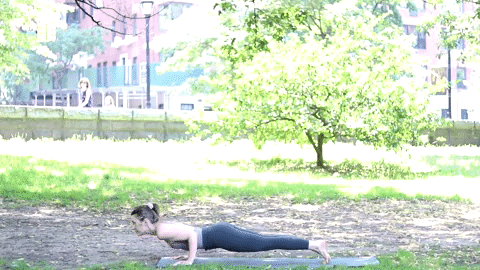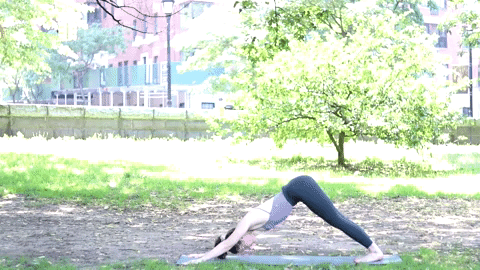Once upon a time, there was a monkey named Hanuman who loved gazing up at the Sun, and dreaming that it was a ripe, juicy mango. One morning, while gazing at the sky, the hungry little Hanuman decided he had to get his paws on that mango.
Using his superpowers, he hurled himself into the sky, took the Sun into his mouth, and took a big, zealous bite. As his mouth burned, he quickly realized it was not a mango and released his grip.
The Sun, angry with Hanuman’s foolishness, struck him with a thunderbolt – breaking his jaw. Realizing his folly and still having much to learn, the young monkey asked the Sun if he could study with him. The Sun hesitantly agreed, but only if Hanuman could keep up with the Sun as he constantly moved throughout each day.
In gratitude for the Sun’s generosity, Hanuman decided that he would pay homage to his teacher the Sun (or Surya) by bowing (‘nama’), and thus, the practice of Surya Namaskar was born.
The Practice of Surya Namaskar
The archaeological discovery of the seals of Harappan shows us that people have practiced Surya Namaskar across Afganistan, Pakistan, and Northern India for almost 6,000 years!
Today people from around the world practice it regularly. If you are only of the 27 million people in the United States who have attended a live or virtual Yoga class, it is almost certain that you have performed a Surya Namaskar or two!
As the story tells it, the practice is a celebration of the sun and is a rhythmic, breath-focused moving meditation.
The practice is a series of linked asana (poses) that are repeated as many times as you’d like, but generally in a set of six of Surya Namaskar A’s and six Surya Namaskar B’s (This is based upon the traditional Ashtanga Yoga practice, although in this article will only be covering Surya Namaskar A).
It is an excellent way for beginners to introduce their minds to an alternative style of meditation through the synchronicity of breath and body to help soothe and quiet the mind.
The Benefits of Surya Namaskar
Beyond this soothing effect, Surya Namaskar also provides significant benefits to both the body and mind. They include:
- It’s a Full Body Movement Practice. In today’s action-packed world, squeezing in time to exercise can be tough. Doing a set of Surya Namaskar, however, can give you a full-body, dynamic movement workout in just a few minutes. Other than increasing circulation, which improves pulmonary function and endurance, it also is an effective way to increase caloric expenditure. More importantly, being a full-body movement practice, it helps increase endurance, muscle composition, and strength — all at once!
- You’ll Love Its Simplicity. Because of its repetitive nature, the practice takes very little prefrontal cortex brain gasoline. In other words, when you’re feeling exhausted and can barely roll yourself out of bed, this practice requires very little thinking. And that means you’re more likely to stick with it.
- Gateway to Meditation. One of the things that makes Surya Namaskar distinct from other exercise routines, however, is that it is more than just exercise. As we’ve discussed, it’s a movement practice and a perfect introduction to meditation. Incorporating the movement element creates an external focus, which is the foundation of a focused attention meditation practice. It’s even great for fidgety kids who can’t stand time on a cushion, but need it.
A Step-by-Step Guide To Doing Surya Namaskar
Before I get into the step-by-step instructions, a few general notes. First, each of these poses are led by a nasal inhalation or exhalation. This means that you should be breathing in and out of your nose if at all possible, and that your body should be following your breath, rather than your breath reacting and catching up to what your body is doing.
As you move through a set of Surya Namaskar, you should take the opportunity to observe your breath as it changes. Adjust your pacing if your breath becomes short or if you find you are not breathing fully.
Breathing in and out through the nose is important because doing so cleanses and warms the air as it enters your lungs. It increases the production of nitric oxide from endothelial cells lining the nasal passages, which in turn increases oxygen consumption and soothes your nervous system.
With that out of the way, here are the poses that make up the Surya Namaskar. Do the poses in this order.
Samasthiti
We begin in Samasthiti with the feet together, toes spread, and kneecaps lifted. Try to find expansion across the front and back sides of the pelvis and heart. Lengthen the back of your neck and tuck your chin down towards the heart. Place your palms together in a “prayer” shape at the heart. This asana allows you to scan your body and mind – re-sensitizing and finding what you can work on during today’s practice. You may choose to stay here for as many breaths as you need – it’s entirely up to you. This is a great asana to return to if you find yourself needing rest or to turn inwards.

Urdhva Hastasana (Upward Salute)
Inhaling, draw the strong arms up and overhead, finding Urdhva Hastasana, keeping the lower body lengthened and engaged and your kneecaps lifted.

Uttanasana (Standing Forward Bend)
On your exhale, swan dive forward. Keep your thighs fully engaged, and your spine and side as long as possible. Draw your fingertips to the ground, a block, or the shins. Try not to round your spine, and maintain the engagement in your inner and outer thighs.

Ardha Uttanasana (Half Standing Forward Bend)
Now, inhale and lift yourself halfway up, gazing forward. Drawing yourself up and make your flat back. Keep your legs firmly engaged with your toes spread. If this is not possible for any reason, drawing the hands instead to the shins is an excellent alternative that allows the spine to remain lengthened and your legs to be fully engaged.

Chaturanga Dandasana (Four-Limbed Staff Pose)
Exhale and step or jump back into a plank, and lower yourself into chaturanga dandasana. To do so, keep your elbows tucked into your ribs, forming 90-degree angles with your arms. Keep your legs fully engaged and press through the soles of your feet.

Urdhva Mukha Svanasana (Upward-Facing Dog Pose)
Inhaling fully, roll over your toes, pressing the toenail side of your feet into the mat. Keeping your thighs fully engaged, arch and broaden your torso upward, straightening your arms, and drawing your shoulders down and away from your ears.

Adho Mukha Svanasana (Downward Facing Dog)
Now, exhale and roll your toes back under and draw your hips skyward, coming into downward dog. Keep your legs fully engaged and your kneecaps lifted. Pressing into your pointer finger and thumb, see how much space you can create between your armpits and hips. Take five long and luxurious breaths.
At the tail end of your last luxurious exhale, gaze forward and step or jump between the hands as lightly and deftly as you can, keeping the upper body long and engaged, drawing your hips skyward.

Ardha Uttanasana (Half Standing Forward Bend)
Return to the half-standing forward bend pose by inhaling and lengthening the spine and engaging your legs. Come into flat back spine.

Uttanasana (Standing Forward Bend)
Exhale and return to the standing forward bend.

Urdhva Hastasana (Upward Salute)
Inhale, and with your legs full engaged, lengthen your side and sweep your arms up and overhead.

Samasthiti
Drawing the hands back to a prayer shape, return back to samasthiti. Notice the effects in the body, and how this shape may feel a bit different from when we began.

Repeat this sequence twelve times, or as many times as desired. When you are done with however many you choose to do, draw yourself into savasana, or corpse pose, by laying flat on your back with your arms laying loosely to your sides with palms facing up. Stay in this pose for as long as you’d like, taking this time to simply note the subtle sensations of your body and mind as you complete your practice.
– – –
Whether this will be your first time, or you’ve done countless Surya Namaskar, go ahead and give this moving meditation practice a try this week with fresh eyes. You might be surprised by how it feels! And if it’s new for you, you may find that its simplicity, full-body nature, and meditative benefits make it a staple in your daily routine!
